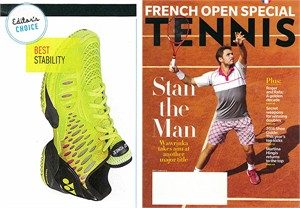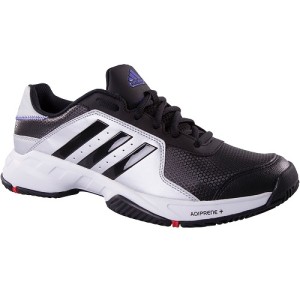
Just about every day, somebody who comes into our store to buy court shoes spends more time looking in the mirror than they do listening to our experts about court shoes. This is unfortunate. Court shoes are not about fashion. They are about performance. With that in mind, these are what your priorities should be when shopping for court shoes.
#1 Traction
Without question, the single most important factor to consider when purchasing a court shoe is traction. Court sports require sudden changes in direction. Sudden changes in direction require one thing above all else: traction. Mess this up and you could get seriously hurt.
Traction is also the most important consideration for our court shoe buyer. He understands that our players need shoes with excellent traction. So he examines every shoe we purchase carefully to ensure that it will serve our players well. If the brand or the model don’t offer sufficient traction, we don’t carry it.
#2 Fit
It may surprise you to learn that fit is actually a more flexible standard than most people think. In fact, most modern court shoes are designed in a way that permits players to wear their actual size or even one half-size bigger. When problems start to occur is when players try (and about half of our customers do) to cram their feet into shoes that are too narrow or too short for their feet.
Shoes are not skates. The rule is this: if you want to avoid foot problems when you are old, wear shoes that fit when you are young. Your toes cannot be crowded; they have to have room to move up and down and even spread out a little inside your shoe. Also important: your circulation should not be cut off, especially on the top of your foot. If you crank your laces like you do when you are tying skates or ski boots, you are cutting off circulation to your feet. A shoe should fit like a winter glove, not a pair of yoga pants.
#3 Function
Most court shoes are multi-functional. For example, badminton shoes can work for squash, volleyball, tennis or pickleball. However, not all court shoes work well for all sports. For example, there are almost no Mizuno volleyball shoes that our experts would recommend to squash, badminton or pickleball players.
In order to figure out which shoes are right for your sport, you really need to ask our experts. Once you pose the initial question, they will ask you a series of questions back. Once they have your answers, they will be able to help you narrow down your choices.
#4 Brand
Brand is almost, but not entirely, irrelevant when it comes to choosing court shoes. “Almost” because there are a few brands that do not make court shoes, or if they do, do not make them very well.
Our expert advice to customers is to ignore brand completely. The reason for this is simple. Too many customers get tunnel vision when it comes to brands. As a result, they end up buying shoes with inferior traction or shoes that don’t fit right or don’t function properly just because they want a particular brand. Teens and tweens are the worst for this. All too often, their top priority in court shoes is brand — not traction, not fit, not function.
#5 Style
Customers in our store often have the luxury of choice when it comes to style. Unless their feet are unusually large or unusually small, we will usually have plenty of shoes in stock that offer the right amount of traction in the right size and for the right sport. After that, it becomes a matter of choosing brands or styles to help narrow down their choices.
Unfortunately, customers with wide feet or other special needs, will never have the same style selection available to customers with “normal” feet. Wide court shoes are extremely hard to find and when our buyer does find them, they are usually bland. So if you have wide feet, focus on traction, fit and function only. Forget about brand and style. Those shouldn’t matter to you at all.




 Yesterday, we had a customer come into our southwest Calgary store to buy a pair of shoes. He wanted to use them for tennis, volleyball and dodgeball. He only wanted to buy one pair of shoes.
Yesterday, we had a customer come into our southwest Calgary store to buy a pair of shoes. He wanted to use them for tennis, volleyball and dodgeball. He only wanted to buy one pair of shoes. Quite simply, all we can so is offer information on the pros and cons. We cannot, in this case, make a recommendation. Carbon rubber will stand up well on acrylic, but it may be dangerously slippery on hardwood. Natural organic rubber provides excellent traction on hardwood, but will quickly be ground down by acrylic. Synthetic rubber offers the best all around compromise, but offers poor traction on hardwood and poor durability on acrylic.
Quite simply, all we can so is offer information on the pros and cons. We cannot, in this case, make a recommendation. Carbon rubber will stand up well on acrylic, but it may be dangerously slippery on hardwood. Natural organic rubber provides excellent traction on hardwood, but will quickly be ground down by acrylic. Synthetic rubber offers the best all around compromise, but offers poor traction on hardwood and poor durability on acrylic.